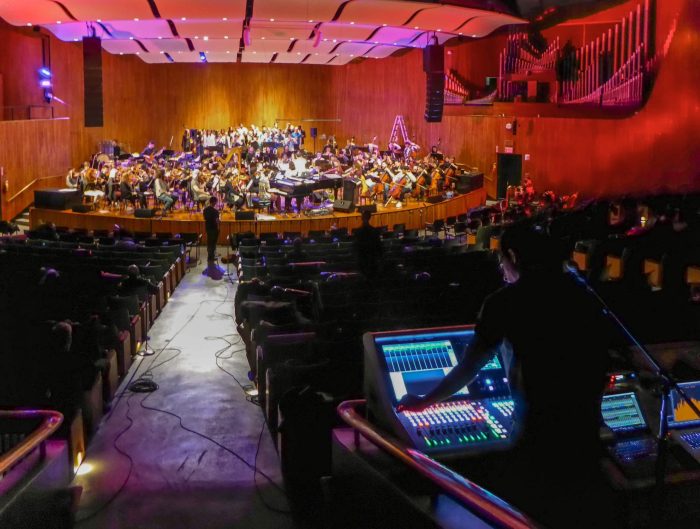British Multi-instrumentalist Jacob Collier rose to internet fame with his split-screen YouTube videos, covering some classic songs in his own original and multi-faceted style. Since then he has collaborated with some of the world’s great musicians, as well as continuing to develop his own unique sound – gaining a well-deserved reputation for exceptional musicianship and musicality.
Since meeting via Facebook in 2014, Collier has been working with Ben Bloomberg, a PhD student and part of the Opera of the Future research group at MIT. Together – and with the help of others – the pair have developed unique instruments such as Collier’s own signature harmoniser, and even live performance software that allows Collier to interact with an ensemble while on stage – sending notation, directions, and articulations in real time to different parts of the ensemble via their smartphones to enable group improvisation.
Recently, Collier performed at the Kresge Auditorium in Cambridge, Massachusetts, as the culmination of a week-long residency at MIT. That performance – called Imagination off the Charts – incorporated an 85-piece orchestra, a 60-voice choir, and a full big band – all on stage with Collier. The main focus of the show was the performance of six commissioned arrangements of songs from Collier’s In My Room album, plus an experimental piece using Collier’s and Bloomberg’s improvised performance software as its foundation.
Bloomberg was at Front of House for the whole thing – a formidable challenge for which he chose the SSL L300 live console.
In total, the system had 96 channels of SSL pre-amps configured, plus an additional AES/EBU Digital Stagebox that fed the PA. The L300 itself has a maximum I/O count of 600 channels and 192 available paths (1008 I/O and 256 paths for the L500), and Collier, of course, came very close to maxing out the L300’s path count. “To be able to find a desk with that amount of resource able to fit into the space we had was fantastic. I’m not sure anything else could have done it. It’s shocking how flexible you can be with that number of inputs and only 26 faders on the surface!”
Seven different schools contributed performers to the ensemble, including MIT, Berkeley, and the New England Conservatoire. “We couldn’t absolutely predict how many instrumentalists we would get,” continues Bloomberg. “Even on the day of the show we had to add two violas. Also, we didn’t actually rent anything for the show – we used some mics from different recording systems, mics from the music department… We ended up with 84 inputs from the stage made up from instrument sections, choir mics, and soloists…The idea was to let the acoustic sound of the strings be the base and then fill in around that. Thanks to the flexibility of the SSL we could run all those mics, plus more recording mics and a recording feed from the console. We actually recorded 85 tracks at 96kHz on a redundant pair of laptops.”
Aside from the sheer number of inputs, there were plenty of other challenges for Bloomberg in the run up to the show, ranging from only having two full rehearsals and two hours with the full ensemble, to the issue of hanging a d&b Y-Series PA in a hall that had never hung a PA before (involving the building’s original architects and two structural engineering companies).
“Because of the limited time we had in rehearsal, just configuring things that fast was a challenge in itself,” says Bloomberg. “We used different layers for different parts of the show – making up various tile layouts for different aspects. We made good use of Stems for instrument groups so I could jump into any section via the stem and use the Query (‘Q’) button to spill those groups out across the faders as I needed to.
“The Query button is something I hadn’t seen before, but I think that’s what made the whole event work. I could jump into layers, in and out of stems and VCAs, and do fast assignments – it works in such a clear and intuitive way.”
Bloomberg also made good use of the L300’s internal effects racks. He had several reverbs set up for different the different ensemble sections, which meant that he didn’t lose important effects treatments if the arrangements changed during the performance. There was a De-Esser and an exciter on Collier’s stem, and the SSL Bus Compressor across the drum stem, but he did find that the standard processing included in every Live processed path – dynamics, tube emulation, EQ, All-Pass filter, delay, and so on – were plenty for most instances. “The special thing about this desk,” explains Bloomberg, “Is that you really don’t have to work very hard to get it to sound good. You bring the faders up and things sound pretty amazing already.”
More information: Solid State Logic / Jacob Collier



